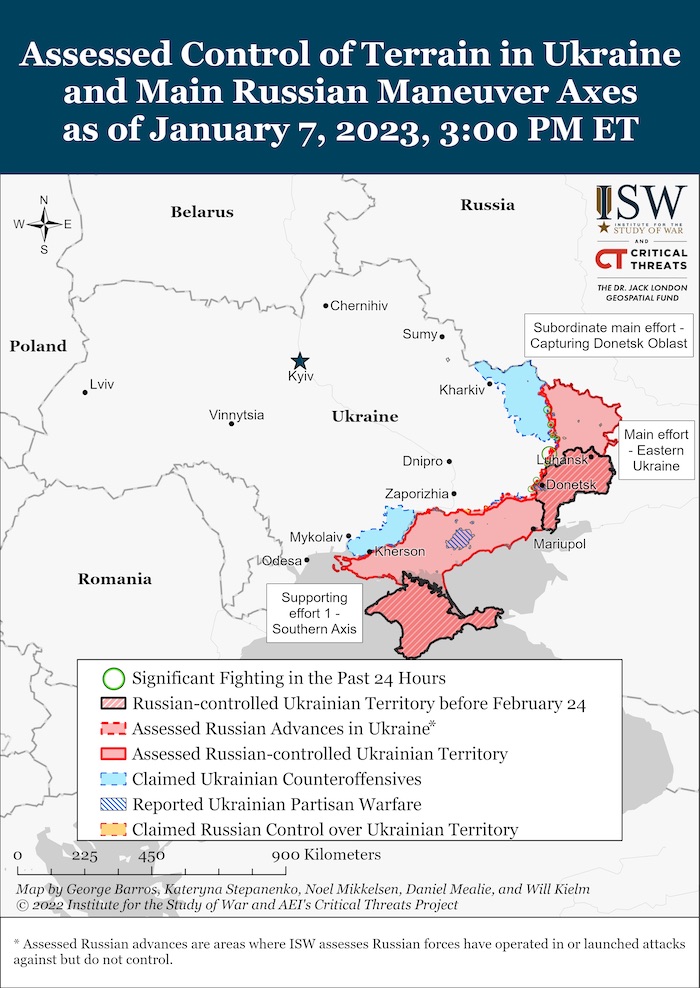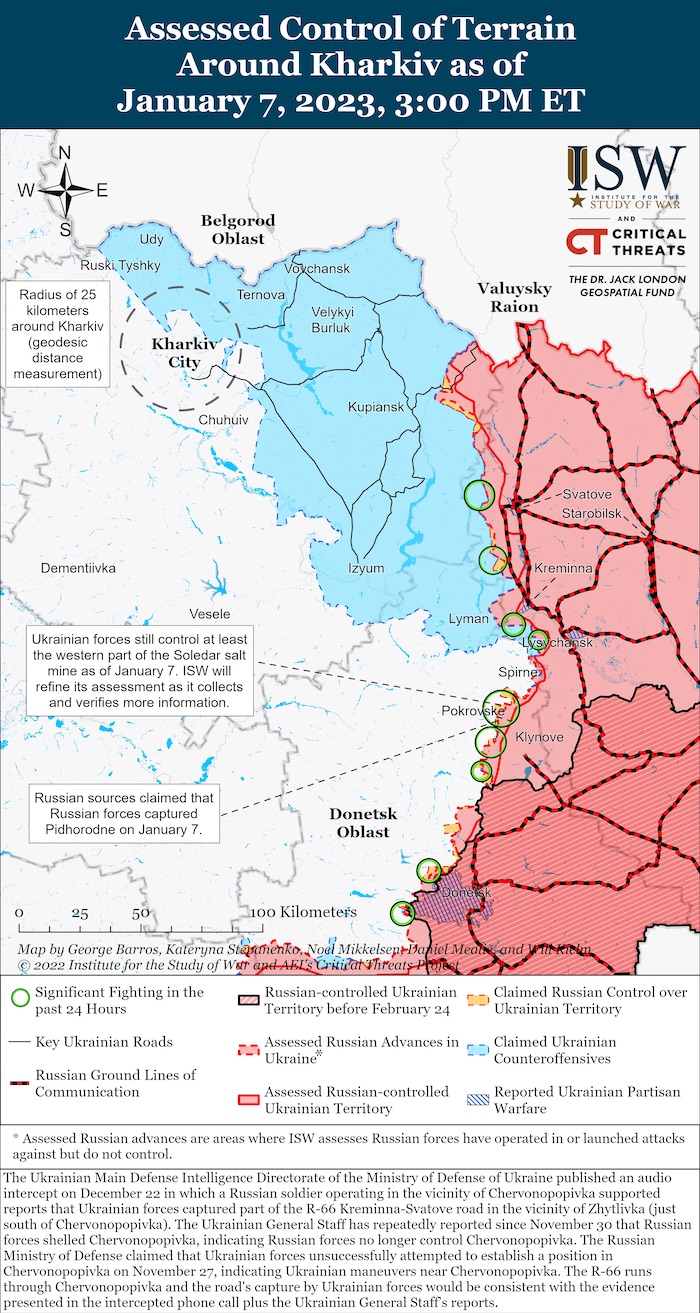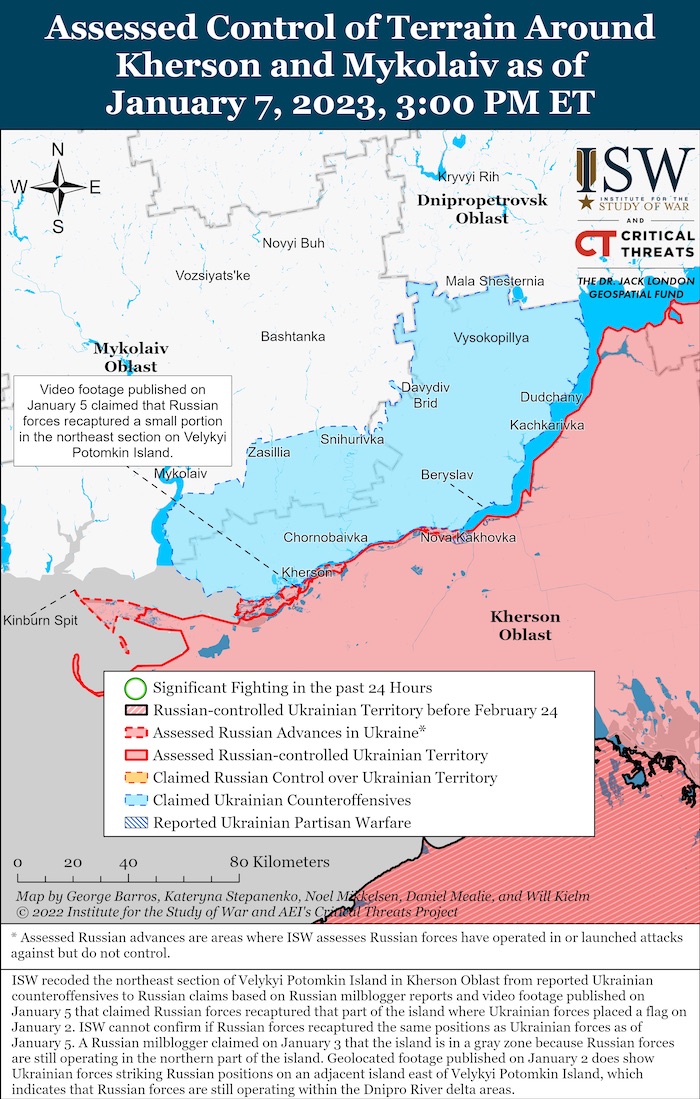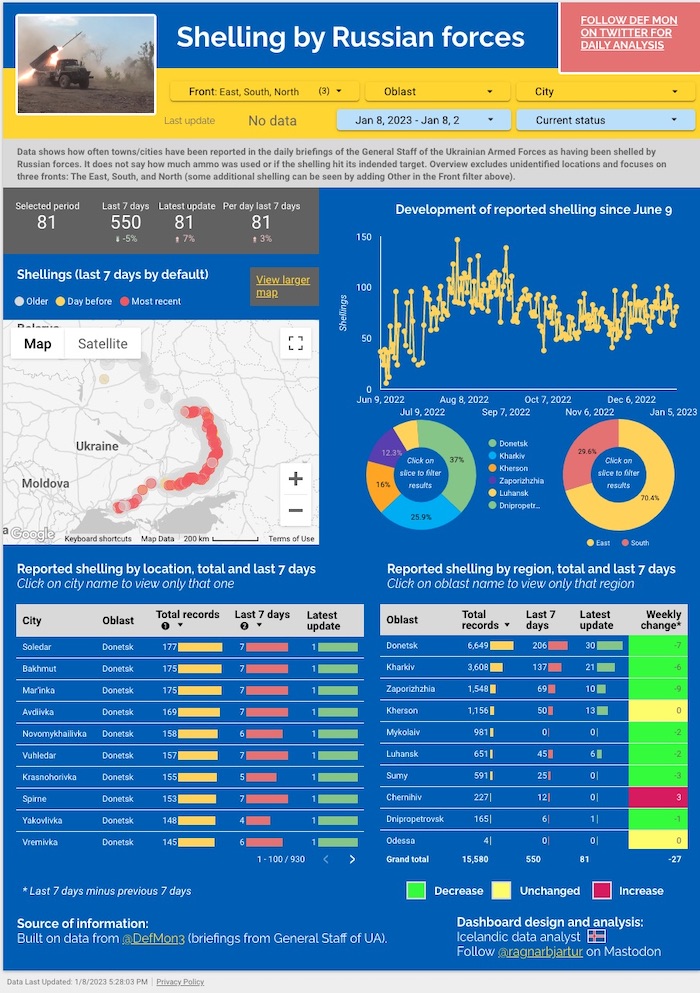Russia continues bolstering its forces in Belarus. Russians transferred 300 Luhansk, Donetsk children to Moscow for “medical treatment.” Ukraine to get record-breaking military assistance worth over 3 billion USD.
Daily overview — Summary report, January 8, 2023
A map of the approximate situation on the ground in Ukraine as of 00:00 UTC 08/01/23. pic.twitter.com/2KVx9nQ17A
— War Mapper (@War_Mapper) January 8, 2023
A close-up map of the approximate situation around the city of Bakhmut.
There have been no confirmed changes to control since the last update. pic.twitter.com/LfNfhFAVpH
— War Mapper (@War_Mapper) January 8, 2023
The General Staff’s operational update regarding the Russian invasion as of 18.00 pm, January 8, 2023 is in the dropdown menu below:




Military Updates

Swamps, forests and shelling: new year on Ukraine’s northern frontline
On New Year’s Eve in a patch of forest along the north-east border with Russia, a unit of Ukrainian territorial defence forces stood guard in their trenches. – reportagehttps://t.co/TtZew5rv8S
— Euromaidan Press (@EuromaidanPress) January 7, 2023
Ukrainian partisans destroy railway lines to disrupt the supply of Russian arms. Serhii Haidai, the head of the Luhansk Regional Military Administration, has said that partisans of the occupied Luhansk Oblast damaged railway lines to disrupt the supply of Russian arms and troops to Ukraine.
Russia plans to mobilize half a million soldiers this January – Ukraine’s Intelligence. Russia is going to mobilize another 500,000 conscripts this January in addition to 300,000 troops that were called up to the Russian army in October 2022, Ukraine’s deputy military intelligence chief Vadym Skibitskyy told the Guardian.
Russia continues bolstering its forces in Belarus. Russia deployed at least 50 units of military equipment to Belarus on 5 January, the Belarusian group of OSINT analysts Belaruski Hayun reported. Russia continues strengthening its group of forces in Belarus, setting conditions for new offensive against Ukraine from the north. According to Belaruski Hayun, the newly arrived batch of Russian military equipment spotted in Belarus yesterday includes:
- around 43 military trucks KAMAZ and Ural
- 5 fuel trucks
- 2 anti-aircraft guns Zu-23-2
- field kitchens and water barrels for the military
According to British Defence Intelligence, (last 48 hours):
- In recent weeks, Russia has bolstered defensive fortifications in central Zaporizhzhia Oblast, southern Ukraine, especially between the towns of Vasilyvka and Orikhiv. Russia maintains a large force in this sector.
- The way Russia has worked on improving defences suggests commanders are highly likely pre-occupied with the potential for major Ukrainian offensive action in two sectors: either in northern Luhansk Oblast, or in Zaporizhzhia.
- A major Ukrainian breakthrough in Zaporizhzhia would seriously challenge the viability of Russia’s ‘land bridge’ linking Russia’s Rostov region and Crimea; Ukrainian success in Luhansk would further undermine Russia’s professed war aim of ‘liberating’ the Donbas. Deciding which of these threats to prioritise countering is likely one of the central dilemmas for Russian operational planners.
Losses of the Russian army

Humanitarian
"Filled with sadness and hopes of a victorious 2023, hundreds of Ukrainian refugees celebrated their first Christmas since fleeing the Russian invasion at a contemporary theatre in Warsaw"https://t.co/zYk0Y4vpgY pic.twitter.com/vaqAQgnmid
— Euromaidan Press (@EuromaidanPress) January 7, 2023
The Head of Ukraine’s Church holds Christmas service at a historic monastery long linked to Russia. On 7 January, Ukrainian attended a service at the Pechersk Kyiv Lavra in Kyiv for the first time as the country celebrates Orthodox Christmas amid Russia’s war. The service was led by the Head of the Ukrainian Orthodox Church of Ukraine, Metropolitan Epiphanius.
Russians transferred 300 Luhansk, Donetsk children to Moscow for “medical treatment”. 300 children from occupied parts of Luhansk and Donetsk oblasts were sent to Moscow for “medical treatment,” the Luhansk Oblast Military Administration reports referring to the Russian occupation authorities of these areas.
Environmental
How a billion lost eggs show challenges for a Ukrainian economic comeback
Avangard Group’s Chornobaivske chicken farm used to export a billion eggs a year, but its dilapidated condition tells of the likely lasting impact of the war on Ukraine’s economy.https://t.co/se0RimskhB
— Euromaidan Press (@EuromaidanPress) January 7, 2023
Support
US imposes fresh sanctions on six individuals tied to linked to Iranian drone manufacturer Quds Aviation Industries
The company is a key manufacturer responsible for the design and production of drones used by Russia against Ukrainehttps://t.co/a3FSoAwzaL
— Euromaidan Press (@EuromaidanPress) January 7, 2023
Poles stand for long-term support of Ukraine, Germans divided – polls. The majority of Polish citizens (82%) are in favor of long-term political and military support for Ukraine by NATO and EU member states in the wake of Russian aggression, while such support among Germans stands at only 42%, according to a survey run by Ipsos in Poland and Germany on December 16-21 for OKO.press and TOK.FM, Ukrinform reports.
Poland considering donating Ukraine its German-made Leopard main battle tanks – WSJ. Back in April 2022, Poland gave Ukraine more than 240 modernized Soviet-era T-72 tanks, now, Poland is considering a request from Ukraine to donate its German-made Leopard main battle tanks, a senior Polish diplomat told WSJ.
Ukraine to get record-breaking military assistance worth over 3 billion USD – US White House. The White House Press Secretary Karine Jean-Pierre has announced a new batch of US military assistance to Ukraine today, on 6 January 2022. It is the biggest military assistance to Ukraine since the Russian large-scale invasion started in February 2022. The military aid package worth over $3,75 billion will include the following:
- 50 Bradley fighting vehicles
- 500 anti-tank missiles and 250,000 rounds of ammunition for armored personnel carriers
- 55 Mini-resistant ambush protected tactical vehicles (MRAP)
- 100 M113 armored personnel carriers
- 138 Humvees (High Mobility Multipurpose Wheeled Vehicles)
- 18 self-propelled howitzers
- 36 howitzers that fire 105-mm ammunition
- surface-to-air missiles, including RIM-7 Sea Sparrow anti-aircraft and anti-missile rockets
- ammunition for HIMARS (High Mobility Artillery Rocket Systems), etc.
US to start training Ukrainians on Patriot missile system later this month, training to take several monthshttps://t.co/fBhF2b07Mi
— Euromaidan Press (@EuromaidanPress) January 7, 2023
US decision to supply Bradley fighting vehicles to Ukraine may pave way to tanks – Politico. The delivery of Bradley fighting vehicles to Ukraine as part of the recent batch of US military aid may pave the way for Western tanks that Ukraine desperately needs for counteroffensive operations, according to Politico.
New Developments
Meeting on war crimes to convene in UK
Justice ministers from around the world will meet in London this March to discuss how to best support investigations of war crimes arising out of Russia’s invasion of Ukraine.https://t.co/g0tRtlJn0H
— Euromaidan Press (@EuromaidanPress) January 7, 2023
Next Ramstein format meeting to be held on Jan 20 – German Defense Ministry. In preparation for the upcoming Ramstein meeting on 20 January 2023, German Defense Minister Christine Lambrecht spoke to US Secretary of Defense Llyod Austin on 6 January at her first international conference call of the new year, Germany’s Federal Ministry of Defense reported.
Assessment
- On the war.
The Institute for the Study of War has made the following assessment as of January 8, 2023:
Recent Russian gains in Soledar do not portend an imminent encirclement of Bakhmut, contrary to claims made by Russian sources. Even at the most generous interpretation of Russian milblogger narratives, which claim that Russian forces are fighting on the outskirts of Razdolivka (about 6km northwest of Soledar), Russian forces are still far from being within striking distance of an operational encirclement of Bakhmut.[1] In order to effectively cut Ukrainian ground lines of communication (GLOCs) into Bakhmut, Russian forces would have to establish control of the T0513 Siversk-Bakhmut highway (currently 7km west of the furthest point of confirmed Russian advances in the Soledar area) and reach the E40 Sloviansk-Bakhmut highway (13km from the furthest point of confirmed Russian advance in the Soledar area) at least. Considering that the recent rate of gains in this area has been on the order of a few hundred meters a day, at most, it is highly unlikely that Russian forces will be successful in cohering a mechanized push towards these GLOCs and move towards encircling Bakhmut.[2] Ukrainian forces in Bakhmut would still have GLOCs available even if the Russians cut the E40, moreover, making the entire discussion of an encirclement at this point bizarre.
Russia continues to weaponize religion to perpetuate long-standing information operations and discredit Ukraine. Russian milbloggers responded to footage posted on January 7 of uniformed Ukrainian servicemen attending Orthodox Christmas services at the Kyiv-Perchesk Lavra and decried it as a reprisal and open war on the Ukrainian Orthodox Church Moscow Patriarchate (UOC MP).[3] Several milbloggers referred to the footage as evidence that the Lavra has been “captured” by “heretics and schismatics.”[4] The milblogger vitriol at the footage of Christmas services at the Lavra follows the decision by the Ukrainian government to take back control of the main cathedral of the Kyiv-Perchesk Lavra from the UOC MP and allow the Orthodox Church of Ukraine (OCU) to hold Orthodox Christmas services at the Lavra on January 7.[5] The Russian response to the Ukrainian government’s decision to transfer control of the Lavra to the OCU exemplifies Moscow’s continued weaponization of religion in order to frame Ukraine as evil and position Russia as the protector of Orthodox Christian values, as ISW has previously reported.[6]
The Ukrainian government has not disrupted the ability of observers to celebrate Orthodox Christmas in Ukraine. Russian milbloggers falsely presented the legal transfer of the Kyiv-Perchesk Lavra from the UOC MP, which the Ukrainian government maintains has explicit links to the Kremlin and has provided material and spiritual support to the Russian war in Ukraine, to the OCU as an attack on the ability of observers of Orthodox tradition to celebrate Christmas. Orthodox services continued through Ukraine, including in the Kyiv-Perchesk Lavra, throughout the course of the day on January 7.[7] The Ukrainian government position that elements of the UOC MP, from which Kyiv removed control of the Lavra, is supported by Russian President Vladimir Putin’s continued association with the Russian Orthodox Church. In his speech on Orthodox Christmas, Putin thanked the ROC for its continued support for Russian troops in Ukraine.[8] Ukraine is not suppressing the religious liberties of Orthodox Christians, contrary to the Russian information operation, and is instead taking the steps it deems necessary to distance Ukrainian cultural heritage from religious elements it asserts are linked to the Kremlin and its conduct of the war.
Russian forces reportedly continue to deplete their missile arsenal but will likely continue to be able to threaten Ukrainian critical infrastructure and civilians at scale in the near term. Ukrainian Defense Minister Oleksii Reznikov published an infographic on January 6 detailing that Russian forces have expended roughly 81 percent of their strategic missile stocks and 19 percent of their tactical missile stocks.[9] Reznikov reported that Russian forces reportedly have remaining of their pre-war and post-invasion production stocks:
92 Iskander 9M723 missiles (11 percent),
52 Iskander 9M728/9M729 missiles (44 percent),
118 Kh-101 and Kh-555/55SM missiles (16 percent),
162 Kh-22/32 missiles (44 percent),
53 Kh-47M2 Kinzhal missiles (84 percent), and
59 sea-based Kalibr missiles (9 percent).[10]
The Russian Ministry of Defense (MoD) stated that it would never run out of sea-based Kalibr missiles while conducting a massive series of missile strikes on December 29, 2022.[11] Russian forces last used sea-based Kalibr missiles in Ukraine during their ninth large-scale series of missile strikes against Ukrainian infrastructure on December 16.[12] Although the Russian military’s tactical missile stock is less expended, S-300 and 3M-55 Onyx missiles are less precise systems than Russian strategic missiles, which is likely why Russian forces have not used these systems extensively in large-scale missile strikes against Ukrainian critical infrastructure.
Reznikov reported that Russia has managed to produce since the February 2022 invasion:
290 Kh-101 and Kh-555/55SM missiles (65 percent of the pre-war stock),
150 Kalibr missiles (30 percent of the pre-war stock),
36 Iskander 9M723 missiles (5 percent of the pre-war stock),
20 Iskander 9M728/9M729 missiles (20 percent of the pre-war stock),
and 20 Kh-47M2 Kinzhal missiles (47 percent of the pre-war stock).[13]
The Russian production of strategic missiles since the start of the invasion of Ukraine in comparison to the Russian military’s pre-war stock highlights that Russia has not mobilized its military industry to support Russian military operations in Ukraine. A country would normally increase the production of missile, rocket, and other weapons systems and munitions before embarking on a major war and would normally put its military industry on a war footing once the war began. Russia has done neither. Putin’s failure to mobilize Russian industry to support the Russian war effort in Ukraine may result from fears that further economic disruptions could produce further domestic discontent in Russia because Western sanctions regimes have placed significant constraints on Russian military industry, or because of inherent limitations of Russian industry and military industry—or some combination of these factors. The current level of the Russian military’s depletion of strategic missile systems may constrain how often and at what scale Russian forces conduct future massive series of missile strikes in Ukraine, but Russian forces will be able to continue their campaign against Ukrainian infrastructure at scale in the near term and threaten the lives of Ukrainian civilians.
Russian forces have also reportedly depleted their arsenal of Iranian-made drones following an increased pace of drone attacks in Ukraine in the past month. Russian forces have reportedly expended 88 percent of their stock of the Shahed-131 and –136 drones that they have so far received from Iran, with only 90 Iranian-made drones remaining according to Reznikov.[14] ISW previously assessed that Russian forces increased their use of Shahed drones in attacks on Ukraine over the past month in order to maintain the pace of their campaign against Ukrainian critical infrastructure without further depleting their more valuable missile stocks.[15] Russia’s contract with Iran reportedly stipulates that Iran will send an additional 1,000 Shahed drones to Russia.[16] Russian forces will likely be able to conduct only a handful of massive drone attacks in Ukraine in the near term until Russia receives from Iran another delivery of drones, which reportedly come in batches of 200 to 300.[17]
Key Takeaways
- Recent Russian gains in Soledar do not portend an imminent Russian encirclement of Bakhmut.
- Russia continues to weaponize religion to perpetuate long-standing information operations and discredit Ukraine.
- Russian forces reportedly continue to deplete their missile arsenal and stock of Iranian-made drones but will likely continue to threaten Ukrainian infrastructure at scale in the near term.
- Russian and Ukrainian forces continued offensive operations near Svatove and Kreminna.
- Russian forces made marginal confirmed advances in Soledar amid continuing Russian offensive operations around Bakhmut and along the western outskirts of Donetsk City.
- Russian forces continue efforts to establish further control over the Zaporizhzhia Nuclear Power Plant (ZNPP).
- Ukrainian and European officials continue to warn that Russia is preparing for an imminent second wave of mobilization.
- Russian occupation authorities continue to transport Ukrainian children to Russian territory under the guise of medical rehabilitation schemes.








